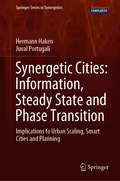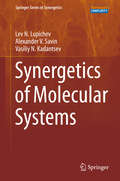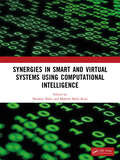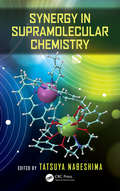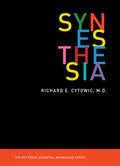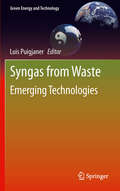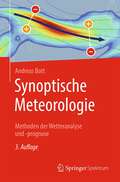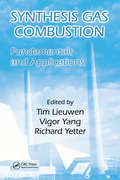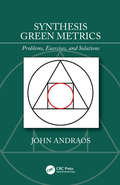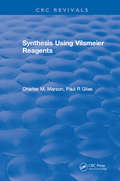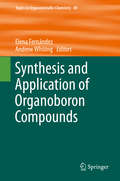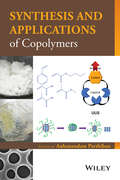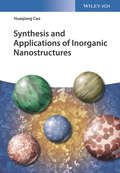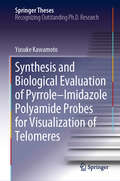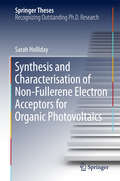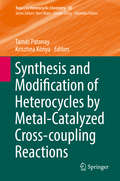- Table View
- List View
Synergetic Cities: Implications to Urban Scaling, Smart Cities and Planning (Springer Series in Synergetics)
by Hermann Haken Juval PortugaliThe book offers a novel approach to the study of the complex dynamics of cities. It is based on (1) Synergetics as a science of cooperation and selforganization, (2) information theory including semantic and pragmatic aspects, and optimization principles, (3) a theory of steady state maintenance, and of (4) phase transition, i.e. qualitative changes of structure or behavior.From this novel theoretical vantage point, the book addresses particularly three issues that stand at the core of current discourse on cities: Urban Scaling, Smart Cities and City Planning.An important consequence of “the 21st century as the age of cities”, is that the study of cities currently attracts scientists from a variety of disciplines, ranging from physics, mathematics and computer science, through urban studies, architecture, planning and human geography, to economics, psychology, sociology, public administration and more. The book is thus likely to attract scholars, researchers and students of these research domains, of complexity theories of cities, as well as of general complexity theory. In addition, it is directed also to practitioners of urbanism, city planning and urban design.
Synergetics of Molecular Systems
by Lev N. Lupichev Alexander V. Savin Vasiliy N. KadantsevSynergetics is the quantitative study of multicomponent systems that exhibit nonlinear dynamics and cooperativity. This book specifically considers basic models of the nonlinear dynamics of molecular systems and discusses relevant applications in biological physics and the polymer sciences. Emphasis is placed on specific solutions to the dynamical equations that correspond to the coherent formation of spatial-temporal structures, such as solitons, kinks and breathers, in particular. The emergence of these patterns in molecular structures provides a variety of information on their structural properties and plays a significant part in energy transfer processes, topological defects, dislocations, and related structure transitions. Real media, in which solitons take the form of solitary waves, are also considered. In this context, the formation of nonlinear waves in a continuous medium described by nonlinear equations is associated with spontaneous breaking of the local symmetry of the homogeneous system, which produces a range of interesting phenomena. A particular feature of this text is its combination of analytic and computational strategies to tackle difficult nonlinear problems at the molecular level of matter.
Synergies in Smart and Virtual Systems Using Computational Intelligence
by Shankar Babu Mahesh Babu KotaWe are delighted to present the preface to the International Conference on Smart Systems, Virtual Intelligence and Robotics Automation using Advanced Electronics and Computational Designs (ICSVREC – 2025). This conference was conceived with the aim of providing a robust interdisciplinary platform for researchers, aca□demicians, professionals, and students to share their research findings, innovative ideas, and technological advancements acros
Synergy in Supramolecular Chemistry
by Tatsuya NabeshimaCooperative and synergistic chemical events have attracted significant attention from many researchers engaged in organic chemistry, inorganic chemistry, biological chemistry, polymer chemistry, medicinal chemistry, and other related materials sciences. Synergistic supramolecular systems could be developed to amplify the functions and integration o
Synergy: The Healing Energy Guiding Stepped Care 2.0
by Peter Cornish Gillian BerrySynergy: The Healing Energy Guiding Stepped Care 2.0 is a hybrid text that explores the theory and practice of synergy as it relates to the Stepped Care 2.0 (SC2.0) model for mental health care. Building on the previous volumes in this series, Stepped Care 2.0: A Paradigm Shift in Mental Health Care, and, Stepped Care 2.0: The Power of Conundrums, this third book consists of a series of essays on synergy, the philosophical idea undergirding SC2.0. Drawing on a wide range of tools from the social sciences and humanities, these essays build an argument for why a holistic and restorative approach to mental health care should incorporate synergistic perspectives and practices arising from global traditions of Indigenous psychology. By blending theory, storytelling, and academic analysis, this book provides an answer to the questions raised in the previous volumes. Using what the editors identify as the Strands of Synergy, it also offers guidance for practitioners seeking to incorporate synergy into their own practice, both in the context of the SC2.0 model, and in the clinical world more generally.
Synesthesia (The MIT Press Essential Knowledge Series)
by Richard E. CytowicAn accessible, concise primer on the neurological trait of synesthesia—vividly felt sensory couplings—by a founder of the field. One in twenty-three people carry the genes for the synesthesia. Not a disorder but a neurological trait—like perfect pitch—synesthesia creates vividly felt cross-sensory couplings. A synesthete might hear a voice and at the same time see it as a color or shape, taste its distinctive flavor, or feel it as a physical touch. In this volume in the MIT Press Essential Knowledge series, Richard Cytowic, the expert who returned synesthesia to mainstream science after decades of oblivion, offers a concise, accessible primer on this fascinating human experience. Cytowic explains that synesthesia's most frequent manifestation is seeing days of the week as colored, followed by sensing letters, numerals, and punctuation marks in different hues even when printed in black. Other manifestations include tasting food in shapes, seeing music in moving colors, and mapping numbers and other sequences spatially. One synesthete declares, “Chocolate smells pink and sparkly”; another invents a dish (chicken, vanilla ice cream, and orange juice concentrate) that tastes intensely blue. Cytowic, who in the 1980s revived scientific interest in synesthesia, sees it now understood as a spectrum, an umbrella term that covers five clusters of outwardly felt couplings that can occur via several pathways. Yet synesthetic or not, each brain uniquely filters what it perceives. Cytowic reminds us that each individual's perspective on the world is thoroughly subjective.
Synesthesia: A Union of the Senses
by Richard E. CytowicA detailed study of synesthesia, an involuntary joining of the senses in which information from one sense joins a perception from another
Syngas from Waste
by Luis PuigjanerSyngas from Waste presents the most recent concepts, methods and techniques for the preliminary design of a promising emerging technology: production of clean syngas from waste materials. An in-depth account is given of the steps necessary to achieve the optimum design and up-to-date tools are presented to support the designer's decision-making tasks: modelling, simulation and optimization. Numerous illustrations and tables are included to facilitate the reader's understanding, as well as suggestions for further reading. The text is complemented with practical examples and industrial applications ranging from clean power generation to complex combined heat and power systems and high purity hydrogen for use in fuel cells. Syngas from Waste contains high-quality contributions from leading experts in the field. It is intended for academics at MSc or PhD level, researchers and industry practitioners in syngas production and applications, who are involved in the design, retrofit design and evaluation activities of alternative scenarios. It contains valuable teaching material for lecturers and provides industry professionals with the know-how to evaluate and improve existing installations or even to design a new one.
Synoptische Meteorologie: Methoden der Wetteranalyse und -prognose
by Andreas BottDas vorliegende Buch beschäftigt sich mit der synoptischen Meteorologie mittlerer Breiten im europäischen Raum. Hierbei wird versucht, die in der angewandten synoptischen Meteorologie interessanten Fragestellungen mit Hilfe der Erkenntnisse aus der theoretischen Meteorologie zu erklären und auf diese Weise eine Verbindung zwischen theoretischer und angewandter Meteorologie zu schaffen. Zunächst erfolgt eine detaillierte Darstellung moderner Beobachtungs- und Messverfahren zur Beschreibung des momentanen atmosphärischen Zustands. Hierzu gehören u.a. die Vorstellung des Stationsmodells sowie die Wolkenklassifikation nach Vorgaben der World Meteorological Organization. Ein Schwerpunkt liegt auf der ausführlichen Diskussion der Mess- und Beobachtungsmethoden auf dem Gebiet der Satelliten- und Radarmeteorologie. Dies geschieht vornehmlich anhand der mit dem europäischen Wettersatellitensystem Meteosat Second Generation gewonnenen Daten und dem vom Deutschen Wetterdienst errichteten Radarverbund zur flächendeckenden Niederschlagserfassung innerhalb Deutschlands. Im weiteren Verlauf des Buchs werden die zur Beschreibung des thermo-hydrodynamischen Zustands der Atmosphäre notwendigen mathematischen Gleichungssysteme vorgestellt und interpretiert. Begriffe wie Hydrostasie, geostrophischer und ageostrophischer Wind, Divergenz, Vorticity sowie unterschiedliche Formen atmosphärischer Instabilitäten werden eingeführt und anhand zahlreicher Anwendungsbeispiele eingehend erörtert. Weitere Schwerpunkte der theoretischen Betrachtungen sind die quasi-geostrophische Theorie sowie die isentrope potentielle Vorticity, die eine Schlüsselgröße in der atmosphärischen Dynamik spielt. Im Anschluss daran erfolgt eine eingehende Diskussion der wichtigsten atmosphärischen Prozesse auf der synoptischen Skala, angefangen bei den Rossby-Wellen, über die darin eingebetteten Zyklonen und Antizyklonen, bis zu den mit der Zyklogenese einhergehenden Frontensystemen. Abschließend widmet sich das Buch mesoskaligen Wetterphänomenen, wie der Bildung von Gewitterzellen, Konvergenzlinien und Nebel.Das Buch richtet sich in erster Linie an Personen, die ein tiefergehendes Verständnis großräumiger atmosphärischer Prozesse anstreben und hierfür die mathematisch-physikalischen Grundprinzipien und Methoden der Meteorologie verwenden möchten.
Synthesis Gas Combustion: Fundamentals and Applications
by Tim C. Lieuwen Vigor Yang Richard YetterCoal, still used to generate more than half of the electric power in the U.S., will likely be part of any future global energy plan. But this finite resource is also responsible for 80 percent of the CO2 emissions from power production, and its continued use will require improved processing techniques that are less damaging to the environment and l
Synthesis Gas: Production and Properties
by James G. SpeightAs a follow-up to the Handbook of Gasification Technology, also from Wiley-Scrivener, Synthesis Gas goes into more depth on how the products from this important technology can reduce our global carbon footprint and lead the United States, and other countries, toward energy independence. The environmental benefits are very high, and, along with carbon capture and renewable fuels, synthesis gas (or syngas) is a huge step toward environmental sustainability. Synthesis gas is one of the most important advancements that has ever occurred in energy production. Using this technology, for example, coal, biomass, waste products, or a combination of two or more of these can be gasified into a product that has roughly half the carbon footprint of coal alone. Used on a massive scale, just think of the potential for reducing carbon emissions!Synthesis Gas covers all aspects of the technology, from the chemistry, processes, and production, to the products, feedstocks, and even safety in the plant. Whether a veteran engineer or scientist using it as a reference or a professor using it as a textbook, this outstanding new volume is a must-have for any library.
Synthesis Green Metrics: Problems, Exercises, and Solutions
by John AndraosGreen chemistry promotes improved syntheses as an intellectual endeavour that can have a great impact both on preserving and utilizing our planet’s finite resources and the quality of human life. This masterful accomplishment provides an evaluation of environmental impact metrics according to life cycle assessment analysis based on the Mackay compartment environmental model and Guinée environmental impact potentials formalism. Assumptions, limitations, and dealing with missing data are addressed. Best literature resources for finding key toxicological parameters are provided and applied to individual reactions as well as entire synthesis plans, in order to target molecules of interest.
Synthesis Using Vilsmeier Reagents (New Directions In Organic And Biological Chemistry Ser.)
by C.M. MarsonSynthesis Using Vilsmeier Reagents presents a comprehensive account of the whole of Vilsmeier chemistry, including the formation of over 50 functional groups and over 50 different ring systems by means of Vilsmeier reagents. The highly structured ordering, by means of functional groups and extensive cross-referencing, enables even the non-specialist to gain an immediate grasp of the subject matter. The potential and versatility of Vilsmeier chemistry makes this major reference work essential for every industrial and academic chemistry library. It should be consulted by every practicing organic chemist and owned by every specialist.
Synthesis and Application of Organoboron Compounds
by Elena Fernández Andrew WhitingThe series Topics in Organometallic Chemistry presents critical overviews of research results in organometallic chemistry. As our understanding of organometallic structure, properties and mechanisms increases, new ways are opened for the design of organometallic compounds and reactions tailored to the needs of such diverse areas as organic synthesis, medical research, biology and materials science. Thus the scope of coverage includes a broad range of topics in pure and applied organometallic chemistry, where new breakthroughs are being achieved that are of significance to a larger scientific audience. The individual volumes of Topics in Organometallic Chemistry are thematic. Review articles are generally invited by the volume editors.
Synthesis and Applications of Carbohydrates, Lipids, and Steroids
by Ahindra NagThis definitive text provides in-depth information on chemical, photochemical, and microbiological synthesis of carbohydrates and their derivatives. Recent development in the synthesis and applications of carbohydrates involved in food industries, biosurfactants, nano-catalysts, and nucleosides are thoroughly discussed in this innovative work. The text also provides information about synthesis and applications of artificial lipids and steroids. The approach of this book is to fulfill the requirements of graduate, postgraduate students, and scientists belonging to various fields.Key features· Provides in-depth knowledge of synthesis and applications of carbohydrates, lipids, and steroids.· Elaborates strategies for stereocontrolled glycosylation and their progress in synthetic carbohydrate chemistry.· Discusses examples derived from drug development and regulatory applications and recent research results.· Enlightens from basics to recent advances in stereoselective glycosylation.· Includes problems with answers based on each chapter.
Synthesis and Applications of Copolymers
by Anbanandam ParthibanUnderstanding the reactivity of monomers is crucial in creating copolymers and determining the outcome of copolymerization. Covering the fundamental aspects of polymerization, Synthesis and Applications of Copolymers explores the reactivity of monomers and reaction conditions that ensure that the newly formed polymeric materials exhibit desired properties. Referencing a wide-range of disciplines, the book provides researchers, students, and scientists with the preparation of a diverse variety of copolymers and their recent developments, with a particular focus on copolymerization, crystallization, and techniques like nanoimprinting and micropatterning.
Synthesis and Applications of Inorganic Nanostructures
by Huaqiang CaoAuthored by a leading figure in the field, this book systematically describes all the fundamental aspects and applications of inorganic nanostructures from zero to three dimensions. It not only discusses various synthesis technologies, but also covers the physical properties of inorganic nanostructures, such as optical, electric and magnetic properties, and practical applications such as energy storage (including Li-ion and Ni-MH batteries and supercapacitors), superhydrophobic and bio-applications, etc. The focus throughout is on the synthesis-structure-application relationships, including the growth mechanisms for the nanostrucutres. Concise yet comprehensive, this is indispensable reading for chemists and materials scientists.
Synthesis and Applications of Nanomaterials and Nanocomposites (Composites Science and Technology)
by Irfan Ahmad Imran UddinThis book brings together multiple aspects of the recent research conducted in the field of nanotechnology covering topics such as the synthesis of various nanoparticles, nanorods, graphene, graphene oxide-metal composites, characterization of these materials, and ample aspects of various applications including in heavy metal sensing, optoelectronic devices, gas sensing, solar cells, biomedical sensors, role in the drug delivery, and waste-water treatment. The book is of interest to early career researchers, who are trying to grasp multiple aspects of nanomaterials and nanocomposite synthesis and its potential applications.
Synthesis and Applications of Nanoparticles
by S. M. Paul Khurana Atul Thakur Preeti ThakurThis book provides thorough information on various nanomaterials, techniques for their synthesis and characterization, and examines their agricultural, environmental, biomedical, and clinical applications. The initial part of the book presents different nanomaterials; covers various physical, chemical, and biological methods for their synthesis; and reviews techniques to characterize their physicochemical and biological properties. Subsequently, the chapters of the book focus on the innovative applications of nanomaterials in disease diagnosis, tissue engineering, regenerative medicine, and cancer therapy. It also explores the green biosynthesis of nanomaterials and highlights their biological applications. Towards the end, the book examines the toxicity and biocompatibility of various nanomaterials. It aims to serve as a resource guide for researchers and biomedical clinicians working with nanomaterials.
Synthesis and Biological Evaluation of Pyrrole–Imidazole Polyamide Probes for Visualization of Telomeres (Springer Theses)
by Yusuke KawamotoThis book presents a novel method of synthesizing sequence-specific DNA binding pyrrole–imidazole (Py–Im) polyamides and demonstrates polyamides targeting longer base pairs than those previously reported and their cellular application. It discusses the development of the facile synthetic method of tandem hairpin Py–Im polyamides and the method of visualizing telomeres under mild conditions without harsh denaturation, as well as research resulting in the synthesis not only of previously reported tandem dimer polyamides but also longer tandem trimer and tetramer polyamides. Using fluorescently labeled tandem hairpin Py–Im polyamides targeting a human telomere repetitive sequence, the author successfully stained telomeres in fixed cells without denaturation. These fluorescently labeled tandem tetramer polyamides are able to visualize human telomeres with lower background signals than previous polyamide probes, suggesting that they have higher specificity for telomeres. As such, this book provides insights into recent advance in Py–Im polyamides, particularly the extension of the target sites c
Synthesis and Characterisation of Non-Fullerene Electron Acceptors for Organic Photovoltaics (Springer Theses)
by Sarah HollidayThis book reports on the design, synthesis and characterization of new small molecule electron acceptors for polymer solar cells. Starting with a detailed introduction to the science behind polymer solar cells, the author then goes on to review the challenges and advances made in developing non-fullerene acceptors so far. In the main body of the book, the author describes the design principles and synthetic strategy for a new family of acceptors, including detailed synthetic procedures and molecular modeling data used to predict physical properties. An indepth characterization of the photovoltaic performance, with transient absorption spectroscopy (TAS), photo-induced charge extraction, and grazing incidence X-ray diffraction (GIXRD) is also included, and the author uses this data to relate material properties and device performance. This book provides a useful overview for researchers beginning a project in this or related areas.
Synthesis and Characterization of Glycosides
by Marco Brito-AriasThis second edition is a short and comprehensive study on the best known approaches for preparing the main types of glycosides. It covers synthetic pathways of challenging glycosides known as antiviral or antineoplastic drugs, and synthetic substrates used for enzymatic detection, including those used for detection of gene markers in plant biotechnology. The author pays special attention to the structural characterization of glycosides and provides the basic tools for the structural assignment through NMR, X-Ray and mass spectra techniques. The book also covers strategies for preparation of antiviral and antineoplastic drugs included in a drug design course.
Synthesis and Characterization of Glycosides
by Marco Brito-AriasThis third edition is a comprehensive and extended study about the best known approaches for preparing the main types of glycosides, covering the classic and more recent glycosylation reactions used for preparing simple and challenging glycosides currently used as potent antiviral and antineoplastic drugs, or fluorogenic substrates used for enzymatic detection in cell biology. Besides, this new edition provides more examples of the glycosidic methodologies followed for preparing complex glycoconjugates such as glycoproteins and glycosphingolipids and gangliosides used as adjuvants or as synthetic vaccines candidates. Also, additional mechanistic evidence is presented for better understanding of the glycosylation reaction, trying to identify the variables mainly depending on protecting and leaving groups, as well as catalyst and reaction condition which altogether directs the anomeric stereo control. A chapter on the glycoside hydrolysis is included in view of the increasing interest in the use of biomass as a natural and renewable source for obtaining important intermediates or products used in food or valuable materials. The author includes information in the characterization of glycosides section with the aim of giving additional tools for the structural assignment through NMR, X-Ray and mass spectra techniques.
Synthesis and Device Applications of Graphene Derivatives and Quantum Dots (Synthesis Lectures on Green Energy and Technology)
by Fangyan SunThe book explores the synthesis methods and device applications of graphene derivatives and quantum dots. The book offers a detailed overview of the synthesis techniques used for these advanced nanomaterials, including solution-phase synthesis, and surface functionalization. It delves into the unique properties and characteristics of graphene derivatives and quantum dots, highlighting their potential for revolutionizing electronic devices. The book also addresses the challenges and limitations associated with their synthesis and device integration, providing valuable insights for researchers and professionals in the field. Written by experts in the field, this book serves as a valuable resource for scientists, engineers, and students interested in exploring the vast potential of graphene derivatives and quantum dots in the development of innovative devices with enhanced performance and functionality.
Synthesis and Modification of Heterocycles by Metal-Catalyzed Cross-coupling Reactions
by Tamás Patonay Krisztina KónyaThe series Topics in Heterocyclic Chemistry presents critical reviews on present and future trends in the research of heterocyclic compounds. Overall the scope is to cover topics dealing with all areas within heterocyclic chemistry, both experimental and theoretical, of interest to the general heterocyclic chemistry community. The series consists of topic related volumes edited by renowned editors with contributions of experts in the field.
